4.3E: Exercises for Section 4.3
- Last updated
- Sep 6, 2022
- Save as PDF
- Page ID
- 112079
( \newcommand{\kernel}{\mathrm{null}\,}\)
1) In precalculus, you learned a formula for the position of the maximum or minimum of a quadratic equation y=ax2+bx+c, which was m=−b2a. Prove this formula using calculus.
2) If you are finding an absolute minimum over an interval [a,b], why do you need to check the endpoints? Draw a graph that supports your hypothesis.
- Answer
- On a closed interval, the endpoints often lie above or below any local (relative) extrema. Answers may vary for the graph.
3) If you are examining a function over an interval (a,b), for a and b finite, is it possible not to have an absolute maximum or absolute minimum?
4) When you are checking for critical points to locate the extrema of a function f, explain why you also need to determine points where f′(x) is undefined. Draw a graph to support your explanation.
- Answer
- Points on the graph of f where there is a corner, a cusp, or a jump discontinuity or removable discontinuity can easily be absolute (or local) extrema of the function. Answers may vary for the graph.
5) Can you have a finite absolute maximum for y=ax2+bx+c over (−∞,∞)? Explain why or why not using graphical arguments.
6) Can you have a finite absolute maximum for y=ax3+bx2+cx+d over (−∞,∞) assuming a is non-zero? Explain why or why not using graphical arguments.
- Answer
- No; answers will vary
7) Let m be the number of local minima and M be the number of local maxima. Can you create a function where M>m+2? Draw a graph to support your explanation.
8) Is it possible to have more than one absolute maximum? Use a graphical argument to prove your hypothesis.
- Answer
- Since the absolute maximum is the function (output) value rather than the x value, the answer is no; answers will vary
9) Is it possible to have no absolute minimum or maximum for a function? If so, construct such a function. If not, explain why this is not possible.
10) [T] Graph the function y=eax. For which values of a, on any infinite domain, will you have an absolute minimum and absolute maximum?
- Answer
- When a=0
In exercises 11 - 14, determine where the local and absolute maxima and minima occur on the graph given. Assume domains are closed intervals unless otherwise specified.
11)
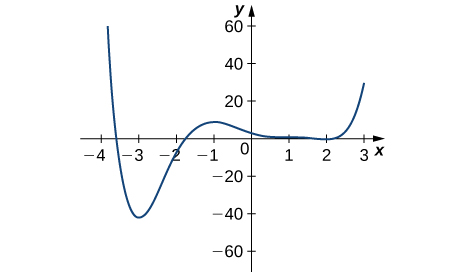
12)
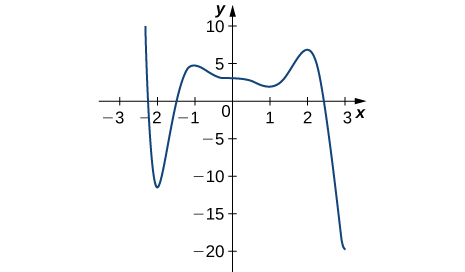
- Answer
- Absolute minimum at 3; Absolute maximum at −2.2; local minima at −2, 1; local maxima at −1, 2
13)
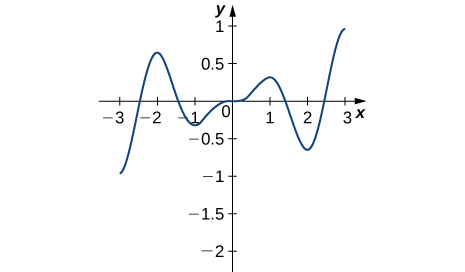
14)
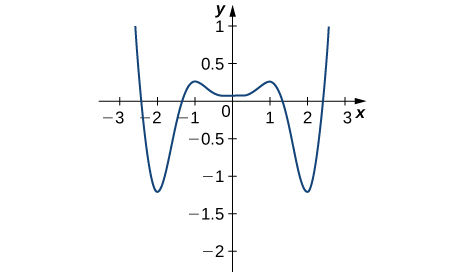
- Answer
- Absolute minima at −2, 2; absolute maxima at −2.5, 2.5; local minimum at 0; local maxima at −1, 1
For exercises 15 - 18, draw graphs of f(x), which is continuous, over the interval [−4,4] with the following properties:
15) Absolute maximum at x=2 and absolute minima at x=±3
16) Absolute minimum at x=1 and absolute maximum at x=2
- Answer
- Answers may vary.
17) Absolute maximum at x=4, absolute minimum at x=−1, local maximum at x=−2, and a critical point that is not a maximum or minimum at x=2
18) Absolute maxima at x=2 and x=−3, local minimum at x=1, and absolute minimum at x=4
- Answer
- Answers may vary.
In exercises 19 - 28, find the critical points in the domains of the given functions.
19) y=4x3−3x
20) y=4√x−x2
- Answer
- x=1
21) y=1x−1
22) y=ln(x−2)
- Answer
- None
23) y=tan(x)
24) y=√4−x2
- Answer
- x=0
25) y=x3/2−3x5/2
26) y=x2−1x2+2x−3
- Answer
- None
27) y=sin2(x)
28) y=x+1x
- Answer
- x=−1 and x=1
In exercises 29 - 39, find the absolute extrema for the functions over the specified domain.
29) f(x)=x2+3 over [−1,4]
30) y=x2+2x over [1,4]
- Answer
- Absolute maximum: x=4,y=332; absolute minimum: x=1,y=3
31) y=(x−x2)2 over [−1,1]
32) y=1x−x2 over [0,1]
- Answer
- Absolute minimum: x=12,y=4
33) y=√9−x over [1,9]
34) y=x+sin(x) over [0,2π]
- Answer
- Absolute maximum: x=2π,y=2π; absolute minimum: x=0,y=0
35) y=x1+x over [0,100]
36) y=|x+1|+|x−1| over [−3,2]
- Answer
- Absolute maximum: x=−3,y=6; absolute minimum: −1≤x≤1,y=2
37) y=√x−√x3 over [0,4]
38) y=sinx+cosx over [0,2π]
- Answer
- Absolute maximum: x=π4,y=√2; absolute minimum: x=5π4,y=−√2
39) y=4sinθ−3cosθ over [0,2π]
In exercises 40 - 45, find the absolute minima and maxima for the functions over (−∞,∞).
40) y=x2+4x+5
- Answer
- Absolute minimum: x=−2,y=1
41) y=x3−12x
42) y=3x4+8x3−18x2
- Answer
- Absolute minimum: x=−3,y=−135; local maximum: x=0,y=0; local minimum: x=1,y=−7
43) y=x3(1−x)6
44) y=x2+x+6x−1
- Answer
- Local maximum: x=1−2√2,y=3−4√2; local minimum: x=1+2√2,y=3+4√2
45) y=x2−1x−1
In exercises 46 - 50, use a calculator to graph the function and to estimate the absolute and local maxima and minima. Then, solve for them explicitly.
46) [T] y=3x√1−x2
- Answer
- Absolute maximum: x=√22,y=32; absolute minimum: x=−√22,y=−32
47) [T] y=x+sin(x)
48) [T] y=12x5+45x4+20x3−90x2−120x+3
- Answer
- Local maximum: x=−2,y=59; local minimum: x=1,y=−130
49) [T] y=x3+6x2−x−30x−2
50) [T] y=√4−x2√4+x2
- Answer
- Absolute maximum: x=0,y=1; absolute minimum: x=−2,2,y=0
51) A company that produces cell phones has a cost function of C=x2−1200x+36,400, where C is cost in dollars and x is number of cell phones produced (in thousands). How many units of cell phone (in thousands) minimizes this cost function?
52) A ball is thrown into the air and its position is given by h(t)=−4.9t2+60t+5m. Find the height at which the ball stops ascending. How long after it is thrown does this happen?
- Answer
- h=924549 m, t=30049 s
For exercises 53-54, consider the production of gold during the California gold rush (1848–1888). The production of gold can be modeled by G(t)=(25t)(t2+16), where t is the number of years since the rush began (0≤t≤40) and G is ounces of gold produced (in millions). A summary of the data is shown in the following figure.
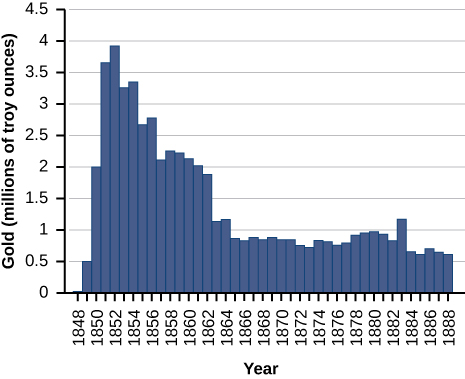
53) Find when the maximum (local and global) gold production occurred, and the amount of gold produced during that maximum.
54) Find when the minimum (local and global) gold production occurred. What was the amount of gold produced during this minimum?
- Answer
- The global minimum was in 1848, when no gold was produced.
In exercises 55 & 56, find the critical points, maxima, and minima for the given piecewise functions.
55) y={x2−4x,if 0≤x≤1x2−4,if 1<x≤2
56) y={x2+1,if x≤1x2−4x+5,if x>1
- Answer
- Absolute minima: x=0,x=2,y=1; local maximum at x=1,y=2
In exercises 57 - 58, find the critical points of the following generic functions. Are they maxima, minima, or neither? State the necessary conditions.
57) y=ax2+bx+c, given that a>0
58) y=(x−1)a, given that a>1
- Answer
- No maxima/minima if a is odd, minimum at x=1 if a is even
Contributors and Attributions
Gilbert Strang (MIT) and Edwin “Jed” Herman (Harvey Mudd) with many contributing authors. This content by OpenStax is licensed with a CC-BY-SA-NC 4.0 license. Download for free at http://cnx.org.
- Paul Seeburger (Monroe Community College) added answers for exercises 2 and 4.

